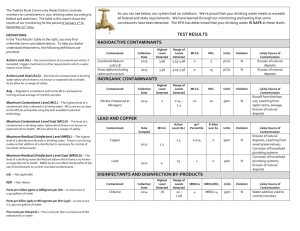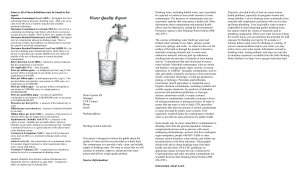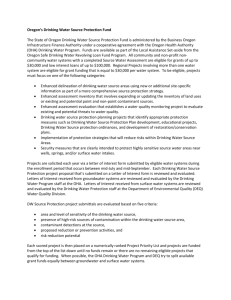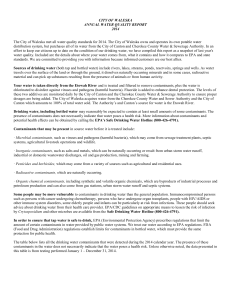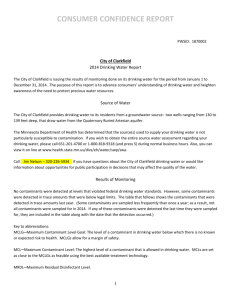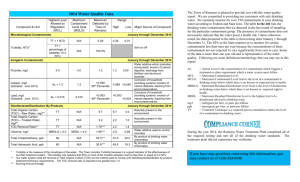SWPP – Source Water Protection Plan SDWISS
advertisement
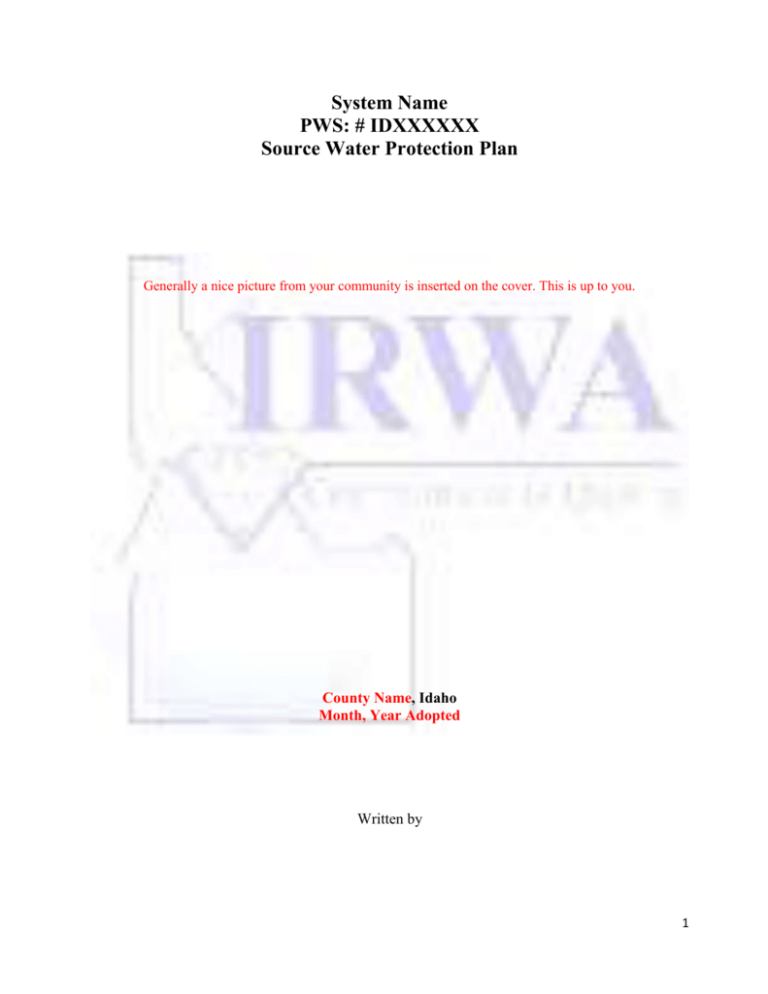
System Name PWS: # IDXXXXXX Source Water Protection Plan Generally a nice picture from your community is inserted on the cover. This is up to you. County Name, Idaho Month, Year Adopted Written by 1 I. Introduction System name operates a public water system that delivers drinking water to approximately xx residents through xx connections (information provided by the system personnel). The system name is located in County Name, Idaho. Members of the community recognize the possibility of potential threats to the town’s water supply and in order to prevent possible contamination of their drinking water they have developed this Source Water Protection Plan. Proactive planning and prevention are essential to both the long-term integrity of the water system and in limiting costs and liabilities to the community. Figure 1: Insert map of city or area receives water from purveyor. Don’t forget to put source of image (for example, google maps). a. Purpose of the Source Water Protection Plan This Source Water Protection Plan (SWPP) is a tool for the system name to ensure clean and high quality drinking water for current and future generations. This SWPP is designed to: Create an awareness of the community’s drinking water sources and the potential risks to water quality within the watershed/aquifer; Encourage education and voluntary solutions to alleviate pollution risks; Promote best management practices to protect and enhance system name’s drinking water supply; Provide for a comprehensive action plan in case of an emergency that threatens or disrupts the community water supply. Developing and implementing drinking water protection measures at the local level (i.e. county and municipal) will complement existing regulatory protection measures implemented by the state and federal government. System name’s source water protection program can achieve a finer level of detail by filling gaps left by large regulatory measures. II. Steps to Developing the Protection Plan The System Name prepared this Source Water Protection Plan in accordance with the guidelines identified in Protecting Drinking Water Sources in Idaho (DEQ, 2000). The system name followed these steps to complete this SWPP: Step 1: Formed a Community Planning Team and invited all stake-holders to participate; Step 2: Formed a list of goals for this Source Water Protection Plan and created a vision statement to express those goals; Step 3: Gathered all delineations, potential contaminant inventories, and source water 2 assessments for the public drinking water sources in the protection area; Step 4: Studied the source water protection area and identified possible potential threats to their drinking water source(s); Step 5: Created a 5-year plan of goals to manage source water protection, including regulatory and non-regulatory measures; Step 6: Ensured they were prepared for the future by updating their Emergency Response Plan or creating a Contingency Plan (up to you) for drinking water emergencies. Step 7: Applied for state certification through the Idaho Department of Environmental Quality. III. Planning Team The Planning Team is a representation of the community/water system as a whole and all possible stakeholders should be given the opportunity to participate in the plan development process. Table 1: Planning Team Members Name Title or Organization Contact Information a. Duties of the Planning Team Name here was selected by the Planning Team to be the Team Coordinator, and as such he/she has the following responsibilities: Planning any future meetings; Leading coordination efforts for the implementation schedule for source water protection measures and activities. The Team Coordinator will also be the lead contact for any outside references to this Plan and will be the designated contact in case of a water system emergency. DEQ and Idaho Rural Water Association (IRWA) will continue to provide support and technical assistance to the Planning Team regarding any of the plan's strategic components. The Planning Team responsibilities are to: Hold annual meetings to review and update this plan and any of its components. Meeting dates may coincide with city council meetings if appropriate. 3 Review and update the potential contaminant source inventories annually by adding any new potential point and nonpoint sources of contamination identified in the delineated source water areas. Coordinate implementation of the strategies identified in this plan to protect system name’s drinking water sources. Use informational materials to implement public education and outreach activities in accordance with the management plan. IV. Goals and Vision Statement Creating formal goals and a vision statement will guide the development of this SWPP. It will also help focus efforts of the Planning Team and community throughout the implementation phase. a. Formation of Goals The Planning Team for system name has identified a set of goals they wish to accomplish with this Source Water Protection Plan. These goals were formed by taking into consideration the needs of the community, long term sustainability of the drinking water system and infrastructure, immediate threats in the area, public health and safety, and any other issues discussed at the Planning Team meetings. The goals for system name’s Source Water Protection Plan are as follows: Goal 1: __________________________________________________________________ Goal 2: __________________________________________________________________ Goal 3: __________________________________________________________________ b. Formation of a Vision Statement The vision statement is an expression of the Planning Team’s dedication to protecting their source of drinking water. It is a formalized statement that represents the vision of the community as a whole and their mission to preserve and protect drinking water sources for current and future generations. The vision of system name’s Planning Team is: Here are some example vision statements to generate ideas: Provide the city of Springfield a safe and reliable source of water for drinking and fire suppression, at a reasonable cost, now and in the future. Develop a plan to protect the drinking water source for the city of Springfield through building partnerships and increasing public awareness. Protect ground water quality for current and future drinking water needs. 4 To achieve long term preservation of a safe and reliable drinking water supply through a proactive approach that balances the needs for ecological protection and economic development that promotes public involvement and partnerships. To maintain an abundant supply of high quality drinking water for present and future needs. Protect the public water source for the City of Springfield now and in the future as part of a multi barrier approach to protect drinking water through increasing awareness and implementing protection strategies. V. Source Water Protection Area The system name is located in the geographical region of Idaho. The city limits cover approximately xxx acres, and the city sits at an elevation of xxxx feet. Here briefly state number or wells and or/source for drinking water used by the system. Description of depth and well, well or intake construction can also be included. a. Source Water Delineations The source water delineation is the physical area around a well that will become the focal point of quality and protection measures. This area can be thought of as a “zone of contribution” where any water contributing to the groundwater sources within the delineated area is contributing to the drinking water sources for the system name. The delineation is completed by the Idaho Department of Environmental Quality for every public drinking water system in Idaho as part of the Source Water Assessment Report. DEQ uses a computer model that assimilates a variety of data, including the system name’s well logs, other local area well logs, and various hydrogeological reports, to map the boundaries of the zone of contribution into groundwater time-of-travel (TOT) zones. These zones indicate the number of years necessary for a particle of water to reach a well. DEQ used a refined computer model approved by the EPA in determining the 3-year, 6-year, and 10-year TOT zones. A complete description of the system name’s hydrogeology can be found in list the original source water assessment final report, which can be found online at: http://www.deq.idaho.gov/water-quality/source-water/assessments.aspx. Delineations for system name’s wells x, x , and x (list all active wells) were performed as part of the system name’s most recent Source Water Assessment. The most current delineations and Source Water Assessment can be viewed online at http://www2.deq.idaho.gov/water/swaonline or by contacting your regional DEQ office. An explanation of the abbreviations used in the delineation maps below can be found in Appendix A. On the next page we will insert maps of the delineation area for your drinking water sources. These maps are found on the DEQ SWA online database. The following is an example, taken from the City of Shoshone’s SWA. 5 Figure 2: Delineation map for the City of Shoshone’s Well #1. 6 Figure 3: Delineation map for the City of Shoshone’s Well #2. 7 Figure 4: Delineation map for the City of Shoshone’s Well #3. 8 b. Land Use The system name has the authority to protect and promote the health, welfare, and safety of the people of community name, and the authority to regulate land use planning and protection of the environment within its boundaries. System name’s municipal wells are located in an urban area. The land use outside of the community name is primarily describe land use – can be found in online swa material. For example, irrigated agriculture, undeveloped range, forest land, etc. c. Susceptibility Here you should discuss the susceptibility of your wells. This will include a discussion of the hydrogeological characteristics of your aquifer and subsurface and the susceptibility rating given in your source water assessment. You can discuss source of recharge to your aquifer, information found in well logs, hydrologic sensitivity (found in the SWA), zones of production, confining layers, etc. d. Zoning Within the city limits of system name there are various types of land use zoning districts. The Planning and Zoning Committee will be using this Source Water Protection Plan, in conjunction with list pertinent ordinances here, to make future zoning decisions on behalf of the community to keep the water sources safe from any possible contamination. e. Planning for Growth Here discuss possibilities of future growth for your community. If heavy growth is not a concern, state that. The Planning Team will work in cooperation with Planning and Zoning to make sure that source water protection measures are taken into account during future land development. If new drinking water sources become necessary, they will be delineated in a manner consistent with the process outlined in the text Protecting Drinking Water Sources In Idaho (DEQ, 2000). The system name will contact Idaho DEQ if there are major changes to an existing source’s construction, discharge rate, or pumping rate. The delineation for the source will be reviewed to ensure that it still represents the appropriate source water protection areas. DEQ will update or modify the delineations if significant new information becomes available. The delineation for any new or modified drinking water source site will be inventoried for any potential contaminant sources, and the risk evaluated. The system name can then take appropriate actions to prevent development that may pose a threat to its drinking water source near the new well site. VI. Potential Contaminant Sources Potential Contaminant Sources are facilities or locations that store, use, or produce potential contaminants as regulated by the Safe Drinking Water Act (DEQ, 2000). If a business or location is designated as a potential contaminant source, there exists a contaminant in great enough quantities to pose a threat to local drinking water sources. However, it is important to understand that the designation of a potential contaminant source does not mean that a 9 business, facility, or property is in any sort of violation of safety standards, or that a leak or release of contaminants will occur. It does mean that the potential for contamination exists due to the nature of the business, facility, or property, and the community and system need to be aware of it. Management of the drinking water sources for the system name included a review phase of the list of potential contaminants compiled from a DEQ database, and then an enhanced inventory phase. The enhanced inventory required members of the Planning Team to tour the area and add any other potential contaminants possibly overlooked. a. Enhanced Potential Contaminant Source Inventory The Planning Team reviewed the potential contaminant source inventory provided by DEQ’s online Source Water Assessment Program. This database was last updated on list date of last update, shown on SWA online database. (Insert names of participants) toured the delineated source water area to perform an enhanced inventory of potential contaminant sources. They were accompanied by _____________ (usually an IRWA or DEQ employee). The purpose of the enhanced inventory is to search for and identify potential contaminants not recognized in the DEQ database. Sources in the DEQ database were also confirmed or disconfirmed in the field. The results of the tour are shown in Table 2. A full list of potential contaminants is included in Appendix X (optional). For an explanation of terms and abbreviations used, refer to Appendix A. The most current version of DEQ’s Potential Contaminant Source Inventory is available online at http://www2.deq.idaho.gov/water/swaOnline/Search. b. Prioritization of Potential Contaminant Sources The Planning Team members accomplished an additional step by prioritizing and ranking the potential contaminant sources according to their known or perceived threat to system name’s aquifer. The potential contaminants were ranked as high, medium, or low threats to the water system. The rankings were decided upon by taking into consideration the proximity of the site to the drinking water source, detection of any known contaminants or past spills at the site, and the type of risk the potential contaminant poses to the source. This priority ranking is presented as the fifth column added to the potential contaminant source inventories on Table 2. Note: this is something the Planning Team will have to do after we perform the enhanced inventory and input data into the table. Table 2: Enhanced Potential Contaminant Source Inventory Name Description Location Potential Contaminants or Concern Rank 10 VII.Source Water Management Tools Implementation of this Source Water Protection Plan is the most important component of the program. Without the continued efforts and support of the Planning Team and the community as a whole, the protection of the system name’s drinking water source may not be accomplished. Ongoing efforts to promote source water protection are vital to ensuring safe drinking water for future generations. Table 3 contains the five-year outline of source water protection measures developed by the Planning Team. These measures are meant to create an ongoing source water protection program that addresses the potential contaminant sources identified in both the Source Water 11 Assessment and the Enhanced Inventory. Note: We can spend time discussing implementation ideas for your system and community. They should be specific measures to address potential contaminants in the area, system deficiencies, and gaps in community knowledge regarding your drinking water source. Table 3: Five-Year Implementation Schedule Protection Responsible Task(s) Activity Party Public Component (Y/N) Date to be Completed Year 1: 20xx Year 2: 20xx Year 3: 20xx Year 4: 20xx Review and update SWPP, Year 5: 20xx Set meeting date. Publicize meeting date Yes 12 including potential contaminant inventory Review and update Contingency Plan at City/County offices, public locations. No VIII. Emergency Response Planning The system name completed an Emergency Response Plan (ERP) in year. Insert name and title here will work with the public works department to update the ERP (usually the Mayor or Planning Team coordinator). Copies of the ERP will be located in list pertinent locations (usually the City Hall, Police and Fire Stations, Public Works buildings, etc). Copies of the ERP will also be provided to council members and local disaster services. Due to matters of water system security, the ERP will not be available for public review. Parties interested in the aspects of the system name’s ERP may contact the City Hall. Note: You may also choose to use a Contingency Plan instead of the ERP. The Contingency Plan is less dense and can be easier to use in an emergency when you need a quick reference for phone numbers and other contacts. If you choose to fill out the Contingency Plan, we will reference that here as well. IX.Public Participation Public participation during the development of this Source Water Protection Plan has included: (Below are listed some ideas to include the public. This is highly encouraged; fill in the ways you would like to encourage public participation in the development of the SWPP.) Community Planning Team open to the public, Notice of Public Meetings; Creation of a Source Water link on the city website; Brochure posted on website explaining SWPP and benefits to the community. Additional public participation will be pursued as part of the implementation process. Interested parties may obtain updated information on the Source Water Protection Plan, protection measures and activities, Source Water Assessments, and drinking water issues by contacting insert name of city staff/planning team member, city website, or location such as City Hall. The system name will pursue additional advertisements for public events as they 13 occur. X.References Generally we will reference the historical Source Water Assessment and online SWA database. I will help fill this section out. 1. DEQ (Idaho Department of Environmental Quality). 2000. Protecting Drinking Water Sources in Idaho. 2. XI. Appendixes (These are just ideas of items to include) Appendix A: Glossary of terms and abbreviations Appendix B: Detailed potential contaminant source inventory Appendix C: Potential Contaminant Inventory Update Forms Appendix D: Contingency Plan or Emergency Response Plan Other items to add to the appendix could include: Ground water susceptibility report from online SWA database Copy of most recent Sanitary Survey Possible protection measures Brochures or instructions for implementation activities 14 Appendix A Glossary of Abbreviations and Terms Taken from Idaho DEQ’s SWA Online: http://www.deq.idaho.gov/water/swaOnline/AcyronymsAndGlossary.aspx Abbreviations and Acronyms AST - aboveground storage tank bgs - below ground surface CAFO – Confined Animal Feeding Operations CAMEO – Computer Aided Management of Emergency Operations CERCLIS - Comprehensive Environmental Response Compensation and Liability Information System EPA - U.S. Environmental Protection Agency DEQ - Idaho Department of Environmental Quality GIS - geographic information system GWUDI – Ground water under direction influence of surface water IDAPA - A numbering designation for all administrative rules in Idaho promulgated in accordance with the Idaho Administrative Procedures act IOC - inorganic chemical LUST - leaking underground storage tank MCL - maximum contaminant level µg/L - micrograms per liter mg/L - milligrams per liter NPDES - National Pollutant Discharge Elimination System PCI – Potential Contaminant Inventory PWS - public water system RCRA – Resource Conservation Recovery Act RCRIS - Resource Conservation Recovery Information System SARA Tier II - Superfund Amendments and Reauthorization Act Tier II facilities SWPP – Source Water Protection Plan SDWISS - Safe Drinking Water Information System, state version SOC - synthetic organic chemical SWA – Source Water Assessment TOT - time of travel TRI - toxic release inventory UST - underground storage tank VOC - volatile organic chemical Glossary of Terms Aquifer – A geologic formation of permeable saturated material, such as rock, sand, gravel, etc., capable of yielding economically significant quantities of water to wells and springs. 15 Low Permeable Unit – A layer of rock or sediment that does not transmit water easily (i.e., clay), thus helping protect the aquifer below from contamination. Analytical Model – A model that provides approximate or exact solutions to simplified forms of the differential equations for water movement and solute transport. Analytical models can generally be solved with calculators or computers. Computer-Aided Management of Emergency Operations (CAMEO) Chemical Facility – A facility that stores or uses hazardous material and is included in the CAMEO Database, which is maintained by the Environmental Protection Agency and National Oceanic and Atmospheric Administration. Community Water System – A public water system that supplies water to at least 15 service connections used by year-round residents or which regularly serves at least 25 year-round residents. Comprehensive Environmental Response Compensation and Liability Act (CERCLA) Site – More commonly known as “Superfund,” CERCLA is federal legislation passed in 1980 designed to clean up hazardous waste sites that are on the U.S. Environmental Protection Agency’s National Priorities List. See http://www.epa.gov/superfund/policy/cercla.htm for more information on CERCLA. Confined Animal Feeding Operation (CAFO) – CAFOs are agricultural operations where animals are kept and raised in confined situations. CAFOs congregate animals, feed, manure and urine, dead animals, and production operations on a small land area. Feed is brought to the animals rather than the animals grazing or otherwise seeking feed in pastures, fields, or on rangeland. See dairy and feedlot definitions. Dairy– A place or premise where one or more milking cows, sheep, or goats are kept, and from which all or a portion of the milk produced is sold for human consumption. Dairies are regulated by the Idaho State Department of Agriculture. Deep Injection Well – These sites may be indicated on the delineation and potential contaminant sources maps. An injection well is a well used as a means to dispose of or store fluids in the subsurface. Deep injection wells, generally used for disposing of storm water runoff or agricultural field drainage, are deeper than 18 feet below ground surface and are regulated by the Idaho Department of Water Resources. Delineation (delineate) – The process of defining or mapping the boundary of the area that contributes water to a particular water source used as a public water supply. Drain Location – Historical method of draining excess water resulting from flood irrigation on agricultural fields by digging a hole from the land surface to an underlying tunnel. Enhanced Contaminant Inventory – See Potential contaminant inventory (PCI) for a definition. 16 Feedlot – A lot or facility where slaughter and feeder cattle or dairy heifers are confined and fed for a total of forty-five days or more during any twelve month period and crops, vegetation forage growth, or post harvest residues are not sustained in the normal growing season over any portion of the lot or facility. Floodplain – The flat or nearly flat land along a river or stream or in a tidal area that is covered by water during a flood. DEQ uses data from the Federal Emergency Management Agency to determine the 100 – year floodplain for any given area. The 100-year floodplain is the area likely to be inundated during a flood that has a 1% chance of being equaled or exceeded in any given year. GIS (geographic information system) – A collection of computer hardware, software, geographic data, and interactive maps used to efficiently capture, store, update, analyze, and display the delineation and potential contaminant sources for source water assessments. Ground Water – Any water which occurs beneath the surface of the earth in a saturated geologic formation of rock or soil. Ground Water Flow – The movement of ground water through openings in sediment and rock that occurs in the zone of saturation. This flow is typically under the influence of gravity. Ground water under the direct influence of surface water (GWUDI) - Any water beneath the surface of the ground with (1) significant occurrence of insects or other macroorganisms, algae, or large diameter pathogens such as Giardia lamblia, or (2) significant and relatively rapid shifts in water characteristics such as turbidity, temperature, conductivity, or pH which closely correlate to climatological or surface water conditions. Hydrologic Sensitivity – Hydrologic sensitivity refers to the susceptibility of a public water system to contamination based on the hydrologic conditions at the source. A well’s hydrologic sensitivity score depends on four factors: 1) the composition of surface soil, 2) the composition of material in the vadose zone, 3) the depth at which ground water is first encountered, and 4) the presence of a low permeable unit. IDAPA – A numbering designation for all administrative rules in Idaho promulgated in accordance with the Idaho Administrative Procedures Act Infiltration – The penetration of water through the ground surface into subsurface soil. Inorganic chemical (IOC) – A chemical substance of mineral origin, without carbon in its atomic structure. Examples include nitrate and arsenic. IOCs can be present in drinking water including ground water and surface water. Landfill – Areas of land or excavations in which wastes are placed for permanent disposal. Leachable Contaminant – Water can collect contaminants as it migrates through wastes, pesticides, or fertilizers. Leachable contaminants can dissolve into water and filter through the soil 17 in a process known as leaching. Leaching may occur in farming areas, dairies, feedlots, and landfills, and may result in hazardous substances entering surface water, ground water, or soil. Maximum Contaminant Level (MCL) – The maximum permissible level of a contaminant in water delivered to any user of a public water system. MCLs are set by the U.S. Environmental Protection Agency and are enforceable standards. Microbial contaminants – Contaminants that include viruses such as Hepatitis; protozoa such as Giardia; and bacteria such as coliform. Coliform is a bacteria found in the digestive tracts of mammals. Their presence in water can indicate fecal pollution. E. coli is one type of coliform bacteria. mg/L – A unit of measurement referring to milligrams per liter. Mine Site – A site where geologic materials are extracted from the earth. Nitrate (NO3) – An inorganic compound containing nitrogen and oxygen. Excessive nitrate concentrations in water can cause severe illness in infants, elderly, and pregnant women. Nitrate is typically introduced to the environment by human activities including: septic systems, animal facilities, fertilizers, manure, industrial waste waters, and landfills. The Environmental Protection Agency MCL for nitrate is 10 mg/L. Nitrate Priority Area – Area where greater than 25% of wells and/or springs that have been sampled have nitrate concentrations greater than or equal to 5 milligrams per liter. National Pollutant Discharge Elimination System (NPDES) Location – These sites, which represent sites with NPDES permits, may be indicated on the delineation and potential contaminant sources map. The federal Clean Water Act requires that any discharge of a pollutant to waters of the United States from a point source must be authorized by an NPDES permit. Organic Compound –Any substance (produced by animals, plants, or humans) that contains mainly carbon, hydrogen, nitrogen, and oxygen in the cellular structure. Permeability – Ability of a porous medium to transmit fluids under a hydraulic gradient. The property or capacity of a porous rock, sediment, or soil for transmitting a fluid; it is a measure of the relative ease of fluid flow under unequal pressure. Pesticide Management Area – An area that is susceptible to pesticide contamination of ground water indicated by elevated pesticide detections in the ground water and requires additional restrictions on pesticide use as determined by the Idaho Sate Department of Agriculture. Phosphate Mine – Sites where phosphate ore is extracted from the earth. Potential Contaminant Source – Any facility or activity that stores, uses, or produces, as a product or by product, the contaminants regulated under the federal Safe Drinking Water Act, and have a sufficient likelihood of releasing the contaminants at levels that could potentially harm 18 drinking water sources. Potential Contaminant Inventory (PCI) – DEQ conducts a PCI to locate and describe facilities, land uses, and environmental conditions within the source water assessment delineation that are potential sources of contamination to ground water or surface water. The PCI is one of three factors used in the susceptibility analysis to evaluate the overall potential contamination risk to a drinking water supply. During the first phase of the PCI, known as the primary contaminant inventory, DEQ staff use computer databases and GIS maps created by DEQ to identify and document potential contaminant sources within the water system’s source water assessment delineation. During the second phase of the PCI, known as the enhanced inventory, DEQ contacts the water system to review the list of potential contaminants identified in the first phase and add any additional potential contaminants not already identified. Public Water System (PWS) – A public water system supplies drinking water to at least 25 people or has at least 15 service connections. Water systems not meeting one or both of these requirements are considered private systems and are not regulated by DEQ. Recharge – The addition of water to the zone of saturation; also, the amount of water added. Sources of recharge may include, but is not limited to, precipitation, irrigation practices, seepage from creeks, streams and lakes, injection (including stormwater injection wells and agricultural drainage injection wells) and land application of wastewater. Recharge can be expressed as a rate (i.e., in/yr) or a volume. Remediation Site – A site where the DEQ Waste and Remediation Program have initiated remediation actions, including Brownfields, above ground storage tanks, leaking UST, RCRA, mining, and emergency response sites. Resource Conservation Recovery Act (RCRA) Site –The Resource Conservation and Recovery Act (RCRA) establishes a federal program to manage hazardous wastes for its entire existence to ensure that hazardous waste is handled in a manner that protects human health and the environment. Facilities that receive hazardous wastes for treatment, storage, or disposal (TSDs) are regulated by the Act, which serves as the basis for developing and issuing permits. Road Salt Location – A location where the Idaho Department of Transportation stores road salt and sand. Safe Drinking Water Act – The Safe Drinking Water Act was originally passed by Congress in 1974 to protect public health by regulating the nation's public drinking water supply. The law authorized the U.S Environmental Protection Agency and states to oversee public water systems and set standards for drinking water. The law was amended in 1986 and 1996 and requires many actions to protect drinking water and its sources: rivers, lakes, reservoirs, springs, and ground water wells. Sanitary Survey –A routine, on-site inspection of a public water system’s water sources, facilities, equipment, operation, and maintenance of a public water system to evaluate the adequacy of those elements for producing and distributing safe drinking water. The purpose of a sanitary survey is to 19 protect public health by identifying system deficiencies and recommending possible solutions. Sanitary surveys in Idaho are conducted by a DEQ staff member or a representative of the local district health department. (DEQ contracts with Idaho’s seven district health departments to assist the state in providing service to small public water systems.) Shallow Injection Well – A well less than or equal to 18 feet deep in which fluids are injected as a means of disposal or for storage in the subsurface, such as stormwater, agricultural water, and facility heating/cooling water. Source Water – Any aquifer, surface water body, or watercourse from which water is taken either periodically or continuously by a public water system for drinking or food processing purposes. Source Water Assessment (SWA) – A source water assessment provides information on the potential contaminant threats to public drinking water sources. Each source water assessment consists of a delineation of the water source area, a contaminant inventory, and a susceptibility analysis. Surface Water(s) – All water which is open to the atmosphere and subject to surface runoff. Lakes, ponds, streams, rivers, and other water bodies which lie on the surface of the land. Surface waters may be partially or fully supplied by ground water. Susceptibility Score – The susceptibility to potential contamination for each well, spring, or surface water intake in a public water system. Before analyzing susceptibility, DEQ defines the source water assessment delineation. Synthetic Organic Chemical (SOC) –Any manmade organic compound. There are many SOCs, including pesticides, herbicides, and many chemicals with industrial uses. SOCs may be present in ground water and drinking water. Time of Travel (TOT) –The number of years necessary for a particle of water to travel in the aquifer to reach a well. Toxic Release Inventory (TRI) Site – These sites may be indicated on the delineation and potential contaminant sources maps. TRI sites indicate locations of potential contaminants identified on the federal Toxics Release Inventory, which is a database made available to public by the U.S. Environmental Protection Agency. The TRI contains information on toxic chemical releases and waste management activities reported annually by certain industries and federal facilities. The TRI list was developed as part of the federal Emergency Planning and Community Right to Know Act passed in 1986. This act requires the reporting of any release of a chemical found on the TRI list. Visit www.epa.gov/tri/trichemicals/ for a full list of chemicals on the TRI. Tunnels – A drainage tunnel historically constructed to drain excess flood irrigation water from agricultural fields. A series of drains in the field empties the excess water into the tunnel. µg/L – A unit of measurement referring to micrograms per liter. 20 UST (Underground Storage Tank) Site – While many types of storage tanks may be buried underground, the term “underground storage tank” refers specifically to certain types of tanks that are regulated under the federal Resource Conservation Recovery Act. These tanks are buried at least 10% underground and store either petroleum products (gasoline, diesel, kerosene, jet fuel) or certain hazardous substances. The underground piping connected to the tanks is also considered part of the UST. USTs are most often found at gas stations and other fueling facilities. For more information, see www.deq.idaho.gov/waste/prog_issues/ust_lust/index.cfm#whatisust. Vadose Zone – In reference to ground water, the vadose zone refers to the zone between the land surface and the water table. Volatile Organic Chemical (VOC) –Any organic compound that easily evaporates at room temperature. VOCs are emitted by a wide array of products numbering in the thousands. Examples include paints and lacquers, paint strippers, cleaning supplies, pesticides, building materials and furnishings, office equipment such as copiers and printers, correction fluids and carbonless copy paper, graphics and craft materials including glues and adhesives, permanent markers, and photographic solutions. VOCs may be present in ground water and drinking water. Wastewater Lagoon – Manmade impoundments for the purpose of storing or treating wastewater. Water Reuse Area – Areas where municipal or industrial wastewater is applied to land for the purpose of land treatment. Well casing – The tube or pipe placed inside a well to protect the water from contamination and prevent the well from caving in. Wellhead – The physical structure, facility, or device at the land surface from or through which ground water flows or is pumped from subsurface water-bearing formations. 21 Appendix B Detailed Potential Contaminant Source Inventory Name Description Location Potential Contaminants or Concern 22 Appendix C Updates to the Potential Contaminant Inventory Source addressed: __________________________________________ Date of inventory update: _____________________________________ Inventory completed by: _______________________________________ Well# Source Description Potential Contaminants or concerns Location Priority Ranking Source addressed: __________________________________________________ Date of inventory update: ____________________________________________ Inventory completed by: _____________________________________________ Well# Source Description Potential Contaminants or concerns Location Priority Ranking 23 24

